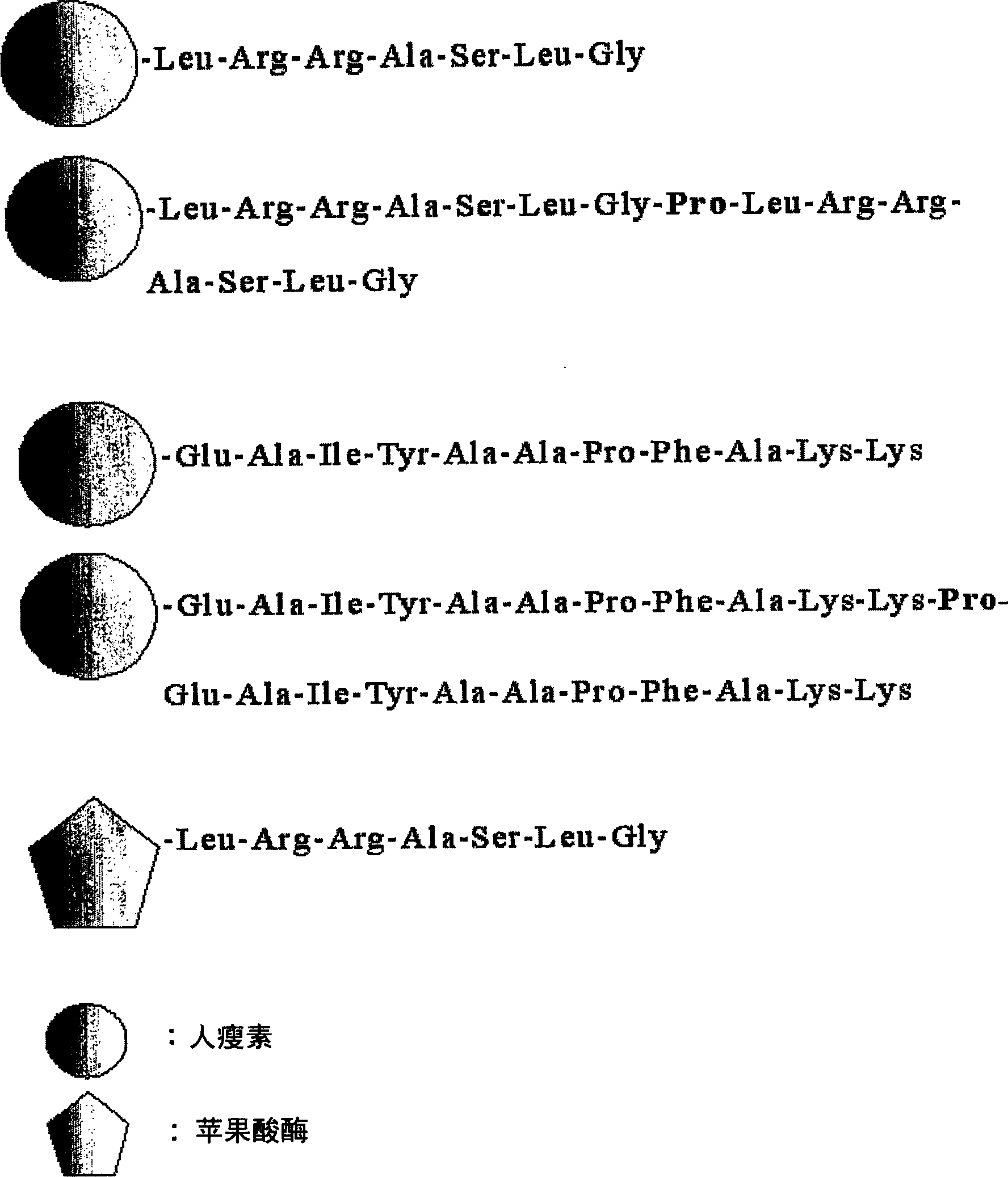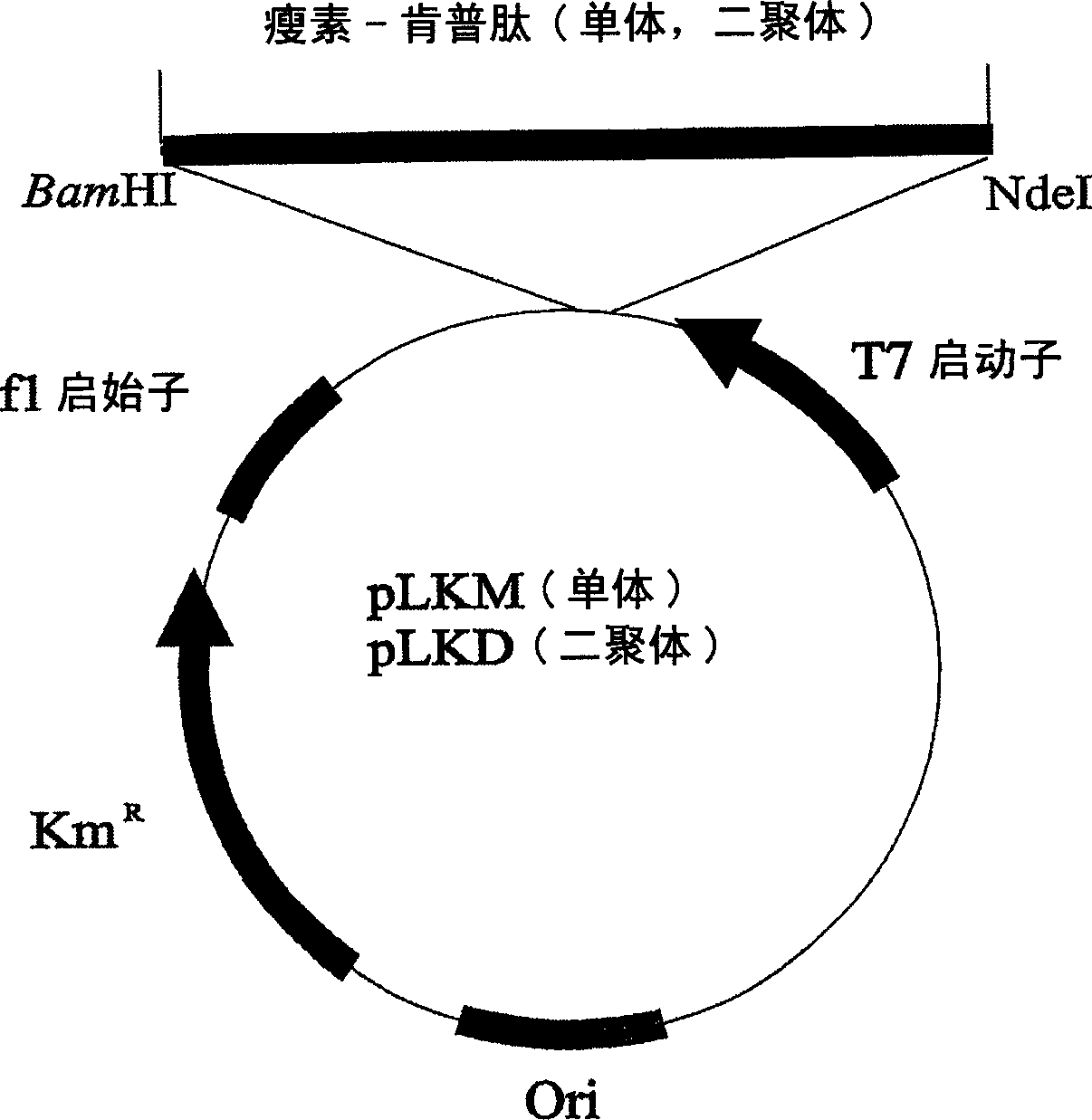A protein chip for analyzing interaction between protein and substrate peptide thereof
A protein chip and substrate peptide technology, applied in the field of protein chips, can solve the problems of low economic benefit, difficulty in practical application, and difficulty in inducing interaction between peptides and reactive proteins, etc.
- Summary
- Abstract
- Description
- Claims
- Application Information
AI Technical Summary
Problems solved by technology
Method used
Image
Examples
Embodiment 1
[0034] Embodiment 1: Construction of recombinant plasmid
[0035] (1) Construction of recombinant plasmids pLKM and pLKD
[0036] Construction of leptin-kemptide protein expressing specificity against protein kinase A ( figure 1 ) recombinant plasmids pLKM and pLKD. In order to fuse the substrate peptide specific for protein kinase A, that is, Kemptide (SEQ ID NO: 1) and human leptin in a monomeric form, perform PCR amplification, and the template DNA used is a recombinant gene containing 414bp leptin Plasmid pEDOb5 (Jeong et al., Appl.Environ.Microbiol., 65(7):3027-32, 1999), the primer 1 used contains the digestion site of restriction enzymes NdeI and BamHI, and the primer 2 used contains the kemptide gene sequence.
[0037] Primer 1 (SEQ ID NO: 2): 5'-CGGAATTCATATGGTGCCCATCCAAAAAGTCCA-3'
[0038] Primer 2 (SEQ ID NO: 3): 5'-GCGGATCCTTAGCCCAGGCTCGCACGACGCAGGCACCCAGGGCTGAGG-3'
[0039] In addition, when fused in a dimer form, PCR amplification was performed using the abo...
Embodiment 2
[0064] Example 2: Analysis of the interaction between leptin-kemptide protein and protein kinase A on a protein chip immobilized with leptin-kemptide protein
[0065] (1) Prepare a protein chip on which leptin-kemptide protein is immobilized
[0066] Recombinant E.coli transformed with recombinant plasmids pLKM and pLKD were inoculated into 200ml LB medium and cultured at 37°C, wherein the recombinant plasmids pLKM and pLKD contained genes encoding leptin-kemptide protein. When the optical density at 600 nm wavelength reached 0.7, 1 mM IPTG was added to induce the expression of leptin-kemptide protein. After 4 hours, the culture broth was centrifuged at 4°C, 6000 rpm for 5 minutes, and the resulting pellet was washed with 100 ml of TE buffer (Tris-HCl 10 mM; EDTA 1 mM, pH 8.0). The washed material was centrifuged at 6000 rpm at 4°C for 5 minutes, and then suspended in 100 ml of TE buffer. The resulting cells were disrupted with a sonicator (Branson Ultrasonics Co., USA).
...
Embodiment 3
[0074] Example 3: Analysis of the interaction between malic enzyme-kemptide and protein kinase A using a protein chip immobilized with malic enzyme-kemptide protein
[0075] (1) Preparation of a protein chip on which malic enzyme-kemptide protein is immobilized
[0076] The recombinant E.coli transformed by the recombinant plasmid pTLMK3 was cultivated under the same conditions as in Example 2-(1), wherein the recombinant plasmid pTLMK3 contained the gene encoding the malic enzyme-kemptide protein, and then the cultured cells were disrupted with a sonicator . The crushed solution was centrifuged at 4°C and 6000rpm for 30 minutes, the supernatant was collected, and the equilibrium solution (50mM NaH 2 PO 4 , 300 mM NaCl, 10 mM imidazole, pH 8.0), followed by purification with a nickel-chelating resin (Quiagen, USA), dialyzed against PBS, and filtered through a 0.2 μm filter. The protein contained in the filtrate was quantified by the same method as in Example 2-(1), and then...
PUM
 Login to View More
Login to View More Abstract
Description
Claims
Application Information
 Login to View More
Login to View More - R&D
- Intellectual Property
- Life Sciences
- Materials
- Tech Scout
- Unparalleled Data Quality
- Higher Quality Content
- 60% Fewer Hallucinations
Browse by: Latest US Patents, China's latest patents, Technical Efficacy Thesaurus, Application Domain, Technology Topic, Popular Technical Reports.
© 2025 PatSnap. All rights reserved.Legal|Privacy policy|Modern Slavery Act Transparency Statement|Sitemap|About US| Contact US: help@patsnap.com



